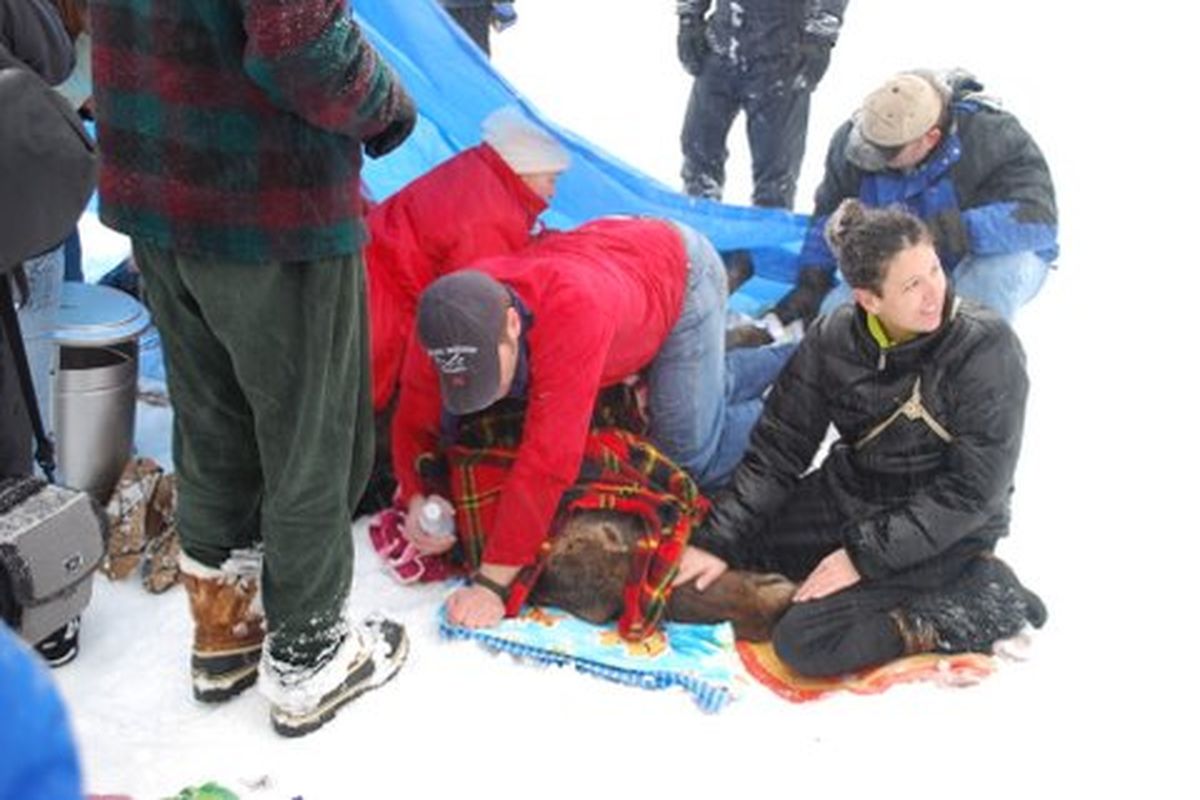Volunteers rescue moose from icy Priest Lake

When a moose crashed through the ice at Priest Lake on New Year’s Day, Good Samaritans from the town of Coolin, Idaho, banded together to save it.
About 30 volunteers took part in the rescue, which included snowshoes, lots of rope, and even some massage therapy for the hypothermic female moose.
Local residents first spotted the struggling animal shortly after daybreak. It was treading water about 100 yards from the shore in Coolin Bay. Eight hours later, the moose had been hoisted out of the lake, warmed up, and fed some oats. The animal, which appeared docile to rescuers, eventually regained enough strength to amble off into the nearby pine forest.
“It was a great way to start 2009,” said Patti Ziegler, who participated in the rescue. “It was a big event for the community. Everyone came together to help save her.”
Idaho Fish and Game officials weren’t present at the rescue. On Friday, however, Officer Craig Walker recommended leaving moose alone.
“It makes a neat story, but I wouldn’t advise anyone to repeat it,” said Walker, a regional conservation officer for Idaho Department of Fish and Game’s Coeur d’Alene office.
Cow moose weigh about 700 pounds. They’re often belligerent, Walker said.
The story could have ended tragically, Walker said – with the moose stomping on the rescuers, or the rescuers crashing through the ice to drown.
Fish and Game officials don’t rescue animals stranded on the ice, he said. The department manages wildlife populations on a landscape level, and saving a single moose isn’t worth the potential loss of human life, Walker said.
Survival rates for animals pulled out of lakes in winter tend to be low, he added. An animal might survive for the short term, but if its body temperature has dropped, it’s hard to keep hypothermia from claiming it, Walker said.
In Coolin, the moose’s predicament quickly drew a crowd. Ziegler and her husband, Reid, had stopped for coffee at Leonard Paul, Coolin’s general store and café. They had planned to spend the day snowmobiling, but abandoned their plans to help.
“We have to save the moose,” Ziegler told her husband.
Another local resident, Thom Wagner, had towed an aluminum boat down to the lake, said Ziegler, recounting the rescue’s chronology. But the ice was too thick to launch the boat, so the general store’s owners lent a chainsaw to help break it up.
Cracking through the ice took too much time. The moose, which was still swimming, appeared weaker.
A woman on snowshoes offered to try to reach the moose. Rescuers tied a rope around her waist, so they could pull her to safety if she fell through the lake’s frozen crust.
The ice held, and the woman was able to lasso the moose’s neck. About six men ventured onto the ice. They pushed the boat with them, so they’d have something to hang on to if the ice broke away beneath them.
The men looped a rope around the moose’s rump and hoisted the animal out of the water. People on shore lined up to grab the rope, towing the moose in.
“We thought it would be dead. It looked almost dead,” Ziegler said.
The moose’s legs were stiff and splayed. Someone brought a plywood board for the moose to lie on. Other people rounded up a tarp to protect it from the heavy, wet snow that was falling. Others brought blankets and a space heater.
Volunteers massaged the moose, rubbing warmth back into its muscles, Ziegler said. They fed it oatmeal and sugar water, a step that Walker cautioned against.
Walker said that moose stomachs change in the winter, adapting to digesting twigs and small branches.
“If a person feeds them alfalfa or gain, sometimes their gut can’t handle it. That can kill them, too,” Walker said.
But after about three hours on the beach, the moose appeared to revive, Ziegler said. Its alertness came back. It steadied on its feet.
To keep the moose from heading back out onto the fog-shrouded lake, volunteers formed a blockade along the shoreline. Ziegler said the moose scrambled up a retaining wall, and trotted off into the woods.
“They’re beautiful creatures up close,” Ziegler said. “We usually don’t get to seem them at close range, because we respect their space.”